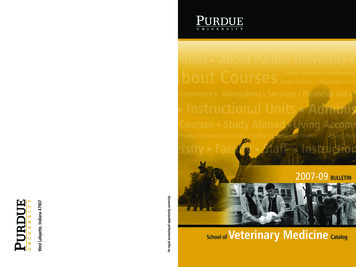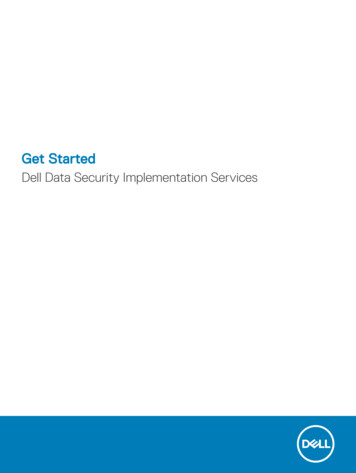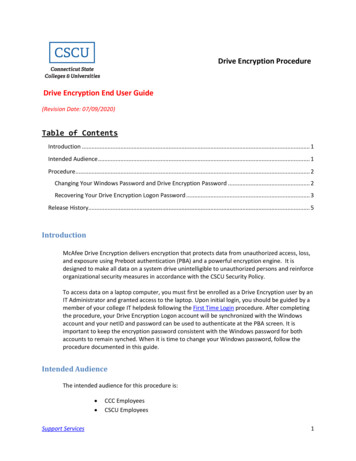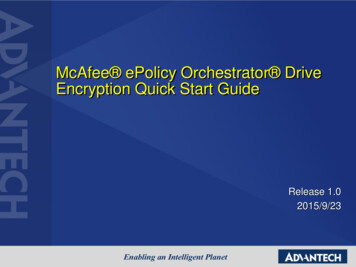
Transcription
Authenticated EncryptionKenny PatersonInformation Security Group@kennyog ; www.isg.rhul.ac.uk/ kp
Motivation for Authenticated Encryption
Authenticated Encryption (AE)m1m2Security goals:Confidentiality and integrity of messages exchanged between Alice and Bob.Adversarial capabilities:Adversary can arbitrarily delete, reorder, modify, etc, bits on the wire.Adversary can mount chosen plaintext and chosen ciphertexts attacks – formalised viaencryption and decryption oracles.Tools we have:Encryption (e.g. block cipher in CBC mode, CTR mode, stream cipher) and MAC algorithms(e.g. HMAC, CBC-MAC).3
Formalising Symmetric EncryptionA symmetric encryption scheme consists of a triple of algorithms: (KGen,Enc,Dec).KGen: key generation, selects a key K uniformly at random from {0,1}k.Enc: encryption, takes as input key K, plaintext m {0, 1} and produces outputc {0, 1} .Dec: decryption, takes as input key K, ciphertext C {0, 1} and produces outputm {0, 1} or an error message, denoted .Correctness: we require that for all keys K, and for all plaintexts m,DecK(EncK(m)) m.Notes: Enc may be randomised (cf. CBC mode, CTR mode). In reality, there will be a maximum plaintext length that can be encrypted by a givenscheme.Nonce-based and stateful formalisms to follow later. 4
Authenticated Encryption – Informal DefinitionA symmetric encryption scheme is said to offer Authenticated Encryption security if:A chosen plaintext attacker (i.e. an attacker with access to an encryption oracle) canlearn nothing about plaintexts from ciphertexts except their lengths.ANDAn attacker with access to an encryption oracle cannot forge any new ciphertexts. What does it mean “to learn nothing about plaintexts from ciphertexts”? How do we formalise “cannot forge any new ciphertexts”? Why is that property important anyway?We use security games, like the one introduced previously for MAC unforgeability.5
IND-CPA security The adversary has repeated access to Left-or-Right (LoR) encryptionoracle. In each query, the adversary submits pairs of equal length plaintexts(m0,m1) to the oracle. We can have m0 m1, so we get an encryption oracle “for free”. The adversary gets back c, an encryption of mb, where b is a fixed butrandom bit. After all queries are made, the adversary outputs its estimate b’ for bit b. The adversary wins if it decides correctly.IND IndistinguishableCPA Chosen Plaintext Attack6
IND-CPA security in a pictureAdversaryChallenger(m0,m1)cb’ Adversary wins if b b’7b {0,1}K KGenc EncK(mb)
IND-CPA securityThe adversary’s advantage in the IND-CPA security game isdefined to be: Pr(b b’) - 1/2 . We have “-1/2” here because a dumb adversary can alwaysguess. A scheme SE is said to be IND-CPA secure if the advantage is“small” for any adversary using “reasonable” resources. Concepts of “small” and “reasonable” can be formalised, butare beyond the scope of this talk. It can be proved that schemes like CBC-mode and CTR-modemeet this security definition if used properly and if they are builtusing a good block cipher.8
Motivating stronger securityIn CBC and CTR modes, an active adversary can manipulateciphertexts and learn information from how these are decrypted. For CTR mode, bit flipping in plaintext is trivial by performing bitflipping in the ciphertext. CBC mode: cut and paste attacks, padding oracle attacks. Or create completely new ciphertexts from scratch? 9Modify c to c XOR Δ to change the underlying plaintext from p to p XORΔ.A random string of bits of the right length is a valid ciphertextfor some plaintext for both CBC and CTR modes!
Motivating stronger security These kinds of attack do not break IND-CPA security, but areclearly undesirable if we want to build secure channels. A modified plaintext may result in wrong message beingdelivered to an application, or unpredictable behaviour at thereceiving application. We really want some kind of non-malleable encryption,guaranteeing integrity as well as confidentiality. Two basic security notions: integrity of plaintexts and integrityof ciphertexts.10
INT-CTXT security in a pictureAdversaryChallengerK KGenmcTry(c*)11Adversary wins if c* is“new” and m* c EncK(m)m* DecK(c*)
Integrity of Ciphertexts – INT-CTXT Attacker has repeated access to an encryption oracle and a “Try” oracle. Encryption oracle takes any m as input, and outputs EncK(m). Try oracle takes any c* as input (and has no output).Adversary’s task is to submit c* to its Try oracle such that:1. c* is distinct from all the ciphertexts c output by the encryption oracle; and2. DecK(c*) decrypts to message m* . Hence adversary wins if it can create a “ciphertext forgery” – a newciphertext that it did not get from its encryption oracle. NB: we do not insist that m* be different from all the m queried to theencryption oracle, only that c* be different from all the outputs of thatoracle.12
INT-CTXT security A symmetric encryption scheme is said to provide INT-CTXTsecurity if the success probability of any adversary usingreasonable resources is small. Again, this can be made precise (but not today!).13
INT-PTXT security in a pictureAdversaryChallengerK KGenmcTry(c*)14Adversary wins if m* is“new” and m* c EncK(m)m* DecK(c*)
INT-PTXT security INT-PTXT: same as INT-CTXT, but now adversary needs tocome up with a ciphertext c* that encrypts a message m* suchthat m* was never queried to the encryption oracle. Informally, INT-PTXT security means that the adversary can’tforce a new plaintext to be accepted by the receiver. If a scheme is INT-CTXT secure, then it is also INT-PTXT secure. For a secure channel, we actually want INT-PTXT security, notINT-CTXT security. (Why?)15
Definitions for AE Security
AE SecurityRecall that a symmetric encryption scheme is said to offer AuthenticatedEncryption security if:A chosen plaintext attacker can learn nothing about plaintexts fromciphertexts except their lengths.ANDAn attacker with access to an encryption oracle cannot forge any newciphertexts.More formally, we can now say that:AE IND-CPA INT-CTXT17
What about chosen ciphertext attacks? We are also interested in security against chosen ciphertextattacks. Here the adversary has access to both an encryption oracle and adecryption oracle. Leading to the IND-CCA security notion, stronger than IND-CPA. This attack model may arise in practice, or the attacker mayhave an approximation to a decryption oracle.18 An attacker might not be able to learn the full plaintext, but could getpartial information about the decryption process, for example, errormessages, timing information, etc. cf. padding oracle attacks, ICMP attack on IPsec, etc.
IND-CCA security in a pictureAdversaryChallenger(m0,m1)c*c /mb’19Adversary wins if b b’b {0,1}K KGenc* EncK(mb) /m DecK(c)
AE Security implies IND-CCA securityInformal reasoning: Suppose we have a successful IND-CCA adversary against an AE-securescheme. Its decryption oracle is only any use to it if it can come up with a new and validciphertext c* not output by the encryption oracle. Because otherwise it knows the underlying plaintext already. But if it can come up with a new ciphertext c*, then it has broken INT-CTXTsecurity! But this creates a contradiction, since AE security implies INT-CTXT security. So we can assume the adversary never comes up with a valid c*. This means we can always reply with “ ” to any decryption query. This means the IND-CCA adversary is effectively reduced to being an IND-CPAone. But this contradicts AE security too, since AE security implies IND-CPA security.20
Relations between security notionsAE:IND-CPA INT-CTXT21IND-CCAIND-CPA INT-PTXTIND-CPAINT-PTXT
AE security and beyond AE security has emerged as the natural target security notionfor symmetric encryption. In part because AE security implies IND-CCA security and INTPTXT security. However it’s not the end of the story:22 In many applications we want to integrity protect some data and provideconfidentiality for the remainder – AE with Associated Data, AEAD. AE security does not protect against attacks on secure channels based onreordering or deletion of ciphertexts. For this, we need stateful or nonce-based security definitions.
Generic composition
Generic composition for AE We have IND-CPA secure encryption schemes (e.g. CBCmode, CTR mode) and we have SUF-CMA secure MACschemes. Can we combine these to obtain AE security for symmetricencryption? Problem first addressed by Bellare-Namprempre (2000) andKrawczyk (2001). Generic options: E&M, MtE, EtM. (In what follows, KM denotes a MAC key, and KE anencryption key.)24
Generic composition for AEEncrypt-and-MAC (E&M) compute c’ EncKE(m) and τ TagKM (m) and output c (c’,τ). used in SSHMAC-then-Encrypt (MtE) compute τ TagKM(m) and output c EncKE (m τ). used in TLSEncrypt-then-MAC (EtM) compute c’ EncKE (m) and τ TagKM (c’) and output c (c’,τ). used in IPsec ESP “enc auth”25
Security of generic composition for AE Generic options: E&M, MtE, EtM. Of these, only EtM gives AE security in general. Assuming encryption is IND-CPA secure and MAC is SUF-CMA secure. Intuition: MACing the ciphertext c’ provides ciphertext integrity; INDCPA security of encryption carries over to the composition. Plus point: check MAC on ciphertext, don’t even decrypt if it fails; notemptation for programmer to “use the plaintext anyway” if MAC fails.26
Security of generic composition for AE To see why E&M fails to be secure in general: Suppose we have a SUF-CMA secure MAC scheme, with taggingalgorithm TagKM (m). Think about the MAC scheme which outputs TagKM (m) m. Is it SUF-CMA secure? What about the security of the resulting E&M scheme?27
Security of generic composition for AETo see why MtE can fail to be secure is more subtle.ExampleConsider the MtE encryption scheme in which MAC is provided byHMAC and the encryption scheme is provided by CBC-modeusing simplified TLS padding.Good MAC (SUF-CMA) and good encryption scheme (IND-CPA)! KGen: select at random two keys, KM, KE. Encryption: c CBC-EncKE (TLS-PAD(m TagKM(m))). Decryption: ?28
Security of MtE generic composition for AE Encryption: c CBC-EncKE (TLS-PAD(m TagKM(m))). Decryption:1. Perform CBC-mode decryption.2. Perform depadding – possibility of padding error.3. Perform MAC verification – possibility of MAC verification error.If the errors at steps 2 and 3 are distinguishable, then we can carry out apadding oracle attack! Padding error - padding bad. MAC verification error - padding good!This attack is a special case of a chosen-ciphertext attack, which should beprevented by AE security (recall AE security implies IND-CCA security).29
Security of MtE generic composition for AE We’ve just seen an example of a scheme constructed fromcomponents that are both good (IND-CPA secure encryptionscheme, SUF-CMA secure MAC) but for which the MtEcomposition fails to be secure. The example is closely related to the construction that is usedin TLS. Specific ways of instantiating MtE can be made secure, but it’sunsafe in general and must be avoided wherever possible.30
AEAD
Authenticated Encryption with Associated Data (AEAD)In practical applications, we often require confidentiality and integrity for somedata fields and only integrity for others.Example: ESP in transport and tunnel modes in IPsecTransport mode:OriginalESP hdrPayloadESP ESPIP headerSPI, seq#(e.g. TCP, UDP, ICMP)trlr authEncryption scopeTunnel mode:MAC scopeOuterESP hdrInnerPayloadESP ESPIP headerSPI, seq#IP header(e.g. TCP, UDP, ICMP)trlr authEncryption scope32MAC scope
Authenticated Encryption with Associated Data (AEAD)An AEAD scheme consists of a triple of algorithms: (KGen,Enc,Dec).KGen: key generation, selects a key K uniformly at random from {0,1}k.Enc: encryption, takes as input key K, associated data AD {0, 1} , plaintextm {0, 1} , and produces output c {0, 1} .Dec: decryption, takes as input key K, associated data AD {0, 1} ,ciphertext c {0, 1} , and produces output m {0, 1} or an errormessage, denoted .Correctness: we require that for all keys K, for all associated data strings AD,and for all plaintexts m:DecK(AD,EncK(AD,m)) m.AEAD security (informal):IND-CPA security for messages m, integrity for combination ofassociated data AD and ciphertext c.33
Nonce-based AEAD
Nonce-based AEADNonce-based AEAD AEAD with nonces!Motivation: AEAD schemes as we have described them so far must consumerandomness in Enc algorithm to achieve AE security (IND-CPA security requires randomised encyption – why?) Guaranteeing good sources of randomness is hard. It’s dangerous to hand this responsibility to the programmer, by asking himto supply the required randomness (e.g. IV for CBC mode). It is arguably easier to ensure that the programmer always passes a newnonce value as one of the inputs to the Enc algorithm (along with messagem and associated data AD).35
Nonce-based AEADA nonce-based AEAD scheme consists of a triple of algorithms:(KGen,Enc,Dec).KGen: key generation, selects a key K uniformly at random from {0,1}k.Enc: encryption, takes as input key K, nonce N {0, 1}n, associated dataAD {0, 1} , plaintext m {0, 1} , and produces output c {0, 1} .Dec: decryption, takes as input key K, nonce N {0, 1}n, associated dataAD {0, 1} , ciphertext c {0, 1} , and produces output m {0, 1} oran error message, denoted .Correctness: we require that for all keys K, for all nonces N, for all associateddata strings AD, and for all plaintexts m:DecK(N,AD,EncK(N,AD,m)) m.36
Security for nonce-based AEADNonce-based AEAD security (informal):IND-CPA security for messages m, integrity for combination ofassociated data AD and ciphertext c, for adversaries that never repeat thenonce in encryption queries.In the IND-CPA security game, the adversary now gets to specify a pair(m0,m1), along with AD and N in encryption queries. Adversary never repeats N.In the INT-CTXT game, adversary now gets to specify m, AD and N inencryption queries. Adversary never repeats N.Idea of nonce restriction: application will ensure an adversary can neveraccess encryption/decryption functionalities with a repeated nonce. 37
Using nonce-based AEADEnc: encryption, takes as input key K, nonce N {0, 1}n, associated data AD {0,1} , plaintext m {0, 1} , and produces output c {0, 1} .Dec: decryption, takes as input key K, nonce N {0, 1}n, associated data AD {0,1} , ciphertext c {0, 1} , and produces output m {0, 1} or an error message,denoted .Notes: For decryption to “undo” encryption, the same value of the associated data ADneeds to be used. But the ciphertext c does not “contain” AD. In applications, AD may need to be sent along with c, or be reconstructed at thereceiver. For decryption to “undo” encryption, the same nonce value N needs to be used. Again, N is not included in the ciphertext c. In applications, then, sender and receiver typically maintain a synchronizedcounter to ensure they both use the same N when encrypting and decrypting.38
Using nonce-based AEADc0c1c2c0 EncK(N 0, AD0, m0)m0 DecK(N 0, AD0, c0)c1 EncK(N 1, AD1, m1)m1 DecK(N 1, AD1, c1)c2 EncK(N 2, AD2, m2)m2 DecK(N 2, AD2, c2) A sends B a sequence of messages m0, m1, m2, using nonce-based AEAD. A uses an incrementing counter for the nonces; B uses the same counter values whendecrypting. What happens if the adversary deletes a ciphertext? What happens if the adversary reorders the ciphertexts, delivering c2 before c1, say? In both cases, receiver will use the wrong counter during decryption, so decryption willfail, producing an error message; adversary learns nothing, and so can’t arrangeundetectable deletion or force a message to be delivered “out of order”.39
Further Constructions
AEAD constructionsSo far we have only seen generic constructions for AE schemes. EtM is the only one that is safe to use. EtM extends to the AEAD setting:c’ EncKE(m); τ’ TagKM(AD c’) and c (c’,τ’). NB this is only secure if the length of AD is fixed or otherwise known to both Enc andDec algorithms. EtM also extends to the nonce-based setting if “E” is a nonce-based encryptionscheme. Example: CBC-mode with IV EK(N) - use key to derive “random” IV block from nonce. Many other AEAD schemes are available; we will look at just two, CCM and GCM.41
CCMCCM Counter with CBC MAC. Basically, an instantiation of MtE with M CBC-MAC and E CTR mode, using a 128-bitblock cipher, e.g. AES.Modifications: Use same key for “M” and “E” components. (Bad idea in general, OK here.) Apply CBC-MAC to the string: h N len(m)64 m len(AD)64 AD padding. Here, “ ” means concatenate, len(X)64 means the 64-bit encoding of the length of stringX. Initial counter value for CTR mode is t N 064, where N is the (64-bit) nonce.CBC MAC42CTR modeencryption
CCMCCM Counter with CBC MAC. CCM is quite slow: it needs one pass over associated data AD in CBC-MAC and twopasses over the message m, one in CBC-MAC and one in CTR-mode encryption. CCM only uses block cipher in “forward direction”, i.e. only “E” and no “D”. CCM is patent-free. CCM is used in WPA2, the successor to WEP and WPA/TKIP. CCM is standardised for use in IPsec and TLS 1.2. CCM is specified in full in RFC 3610 (https://tools.ietf.org/html/rfc3610). CCM has as a security proof based on block cipher being a pseudo-randompermutation. No known attacks (when implemented properly!)43
GCMGCM Galois Counter Mode. Basically, an instantiation of EtM with E CTR mode using a 128-bit block cipher, e.g.AES, and M a Wegman-Carter MAC. Nonces N can be of arbitrary length, special processing for 96-bit case for speed. Faster than CCM: speed up comes from use of fast MAC algorithm built from universalhash function family called GHASH. GCM only uses block cipher in “forward direction”, i.e. only “E” and no “D”. AD and m can be processed in block-wise fashion, no buffering required. GCM is patent-free. GCM is standardised for use in IPsec and TLS 1.2, now widely used in TLS. GCM is specified in full in NIST Special Publication SP800-38D (2007). GCM has a security proof based on block cipher being a pseudo-random permutation. No known attacks of significance (when implemented properly!)44
GCM (for 96-bit nonces)CTR modeencryptionN 1031Encryptionmask foruniversalhash45ADUniversal hash function onAD c len(AD)64 len(c)64.
Other things you should probably know about AE Other modes are seeing growing adoption, e.g. OCB. Recent SHA-3 winner KECCAK can be adapted to produce an AE scheme! The whole area was mired in patents on early algorithm designs but thesituation is gradually improving. Don’t rely on wikipedia for discussion of the security of generic composition(it says MtE is OK; it’s not in general)! CAESAR competition on-going ing lots of new research activity and some controversy. See also the AE zoo https://aezoo.compute.dtu.dk/doku.php46
Going Still Further
AEAD secure channel Think about the application developer: She/he wants a drop-in replacement for TCP that’s secure.Actually, she/he might just want to send and receive someatomic messages and not a TCP-like stream. To what extent does AEAD meet this requirement? It doesn’t 48
AEAD secure channelEnc(.,.,.) m1Chm2Dec(.,.,.)There’s a significant semantic gap between AEAD’s functionalityand raw security guarantees, and all the things a developerexpects a secure channel to provide.49
Example: cookie cuttersBhargavan, Delignat-Lavaud, Fournet, Pironti, Strub 2014: cookiecutter attack on “HTTP over SSL/TLS”. Attacker forces part of the HTTP header (e.g., cookie) to be cutoff. Partial message/header arrives and might be misinterpreted.c Enc(Set-Cookie:50SID [AuthenticationToken]; secure)Set-Cookie: SID [AuthenticationToken]Ch
Cookie cuttersWhy doesn’t this violate the proven integrity of SSL/TLSencryption?6.2.1. FragmentationThe record layer fragments information blocksinto TLSPlaintext records [.]. Clientmessage boundaries are not preserved in therecord layer (i.e., multiple client messagesof the same ContentType MAY be coalesced intoa single TLSPlaintext record, or a singlemessage MAY be fragmented across severalrecords).RFC 5246 TLS v1.251
Cookie cuttersWhy doesn’t this violate the proven integrity of SSL/TLSencryption?6.2.1. FragmentationThe record layer fragments information blocksinto TLSPlaintext records [.]. Clientmessage boundaries are not preserved in therecord layer (i.e., multiple client messagesof the same ContentType MAY be coalesced intoa single TLSPlaintext record, or a singlemessage MAY be fragmented across severalrecords).RFC 5246 TLS v1.252
Cookie cutters So SSL/TLS can (and will) fragment when sending. Compare to SSH that has to deal with fragments whenreceiving. Both protocols provide a streaming interface toapplications, not a message-oriented one.Set-Cookie:SID [AuthToken]ChSetCookie:SID 2 TLS records53Set-Cookie:SID [AuthToken];secure
Cookie cutters It’s up to the calling application to deal with message boundaries if itwants to use SSL/TLS for atomic message delivery. Cookie cutter attack relies on a buggy browser that does not checkfor correct HTTP message termination. This happens in practice, presumably because developers do notunderstand the interface provided by SSL/TLS.Set-Cookie:SID [AuthToken]54ChSetCookie:SID Set-Cookie:SID [AuthToken];secure
From AEAD to secure channels
From AEAD to secure channels SSL/TLS is not alone in presenting a streaming interface to applications.Also SSH “tunnel mode”, QUIC.What security can we hope for from such a channel?Boldyreva-Degabriele-Paterson-Stam (2012) alreadytreated the case where the receiver handles fragmentedciphertexts (but the sender does not produce them). Model tuned to treatment of SSH encryption.In Fischlin-Günther-Marson-Paterson (2015), we provideda systematic study of the case where both sender andreceiver may fragment, as in TLS.56
Streaming secure channels (FGMP15) Defining CCA and integrity notions in the fullstreaming setting is non-trivial! Hard part is to define when adversary’s decryption queriesdeviate from sent stream, and from which point on tosuppress decryption oracle outputs. We develop streaming analogues of IND-CPA, INDCCA, INT-PTXT and INT-CTXT. We recover an analogue of the classic relation:IND-CPA INT-CTXT è IND-CCA57
Closing remarks
Closing remarks We’ve seen the evolution from simple security modelsfor symmetric encryption to more sophisticatedsecurity notions for secure channels. Yet the relevant part of the cryptography communityis mostly focussed on AEAD and CAESER. Key take-away: think top-down, not bottom-up (fromAPI to crypto, not the reverse). You’ve almost arrived at the research frontier! And there are lots of interesting problems left tosolve!59
Closing remarks60
A symmetric encryption scheme is said to offer Authenticated Encryption security if: A chosen plaintext attacker (i.e. an attacker with access to an encryption oracle) can learn nothing about plaintexts from ciphertexts except their lengths. AND An attacker with access to an encryption oracle cannot forge any new ciphertexts.










